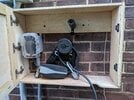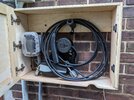stopcrazypp
Well-Known Member
FYI, for anyone buying the Hubbell 9450A or the Bryant 9450FR receptacles (which is what I did at Grainger, given it's much less expensive for essentially the same part) note that Leviton does make a clone of the SS701 face plate for the larger non-standard 2.465" diameter hole.
SS701-40
Given Home Depot and Lowes does not stock any similar plate, I looked around and found Ace Hardware does stock a version with model number 0S701-040. Just went and bought it and verified it is 2.465". Will install in weekend to know for sure if it fits, but not foreseeing an issue (given the other plates are much smaller and there doesn't appear to be a third type of size).
Leviton Silver 2 gang Stainless Steel Receptacle Wall Plate 1 pk - Ace Hardware
Here's the Amazon listing for what appears to be the same item looking at the pictures (shipped/sold by Amazon):
Amazon.com
They also sell a plastic version (and a 430 SS version called the SL701).
Amazon.com
And an aluminum finish:
https://www.amazon.com/Leviton-S701-GY-001-0S701-0Gy-Receptacle-Standard/dp/B000HEHF0W
So actually a lot of inexpensive options in a whole lot of finishes that doesn't have to be the actual Hubbell branded one (which is not as available). I'm going to use that Leviton plate with a 5/8" raised mud ring to give plenty of box volume (a minimum amount apparently is required to meet NEC even though a lot of DIY 14-50 installs don't even mention this). I'm going to be going with surface mount (given my subpanel is surface mounted), so the differences in depth don't really matter, but if you are installing in drywall then it may matter for you.
I was going to buy a raised 4"x4" exposed work cover instead of a stainless steel cover, but the Home Depot/Lowes local to me don't appear to stock the sizes that have the larger hole (they only have the ones for more standard 2-5/32" / 2.156" diameter holes) and I don't want to drive out of the way to get it. But for people interested in ones with larger holes, the Rayco 813C and Steel City RS14-10R appear to have the larger hole.
RACO 30-60 Receptacle Exposed Work Cover-813C - The Home Depot
Steel City 4 in. Pre-Galvanized Metal Square Electrical Box Surface Cover-RS14-10R - The Home Depot
Note if you are using a larger 4-11/16" box you would need to find a different work cover, probably the Raco 888:
888 | Raco
SS701-40
Given Home Depot and Lowes does not stock any similar plate, I looked around and found Ace Hardware does stock a version with model number 0S701-040. Just went and bought it and verified it is 2.465". Will install in weekend to know for sure if it fits, but not foreseeing an issue (given the other plates are much smaller and there doesn't appear to be a third type of size).
Leviton Silver 2 gang Stainless Steel Receptacle Wall Plate 1 pk - Ace Hardware
Here's the Amazon listing for what appears to be the same item looking at the pictures (shipped/sold by Amazon):
Amazon.com
They also sell a plastic version (and a 430 SS version called the SL701).
Amazon.com
And an aluminum finish:
https://www.amazon.com/Leviton-S701-GY-001-0S701-0Gy-Receptacle-Standard/dp/B000HEHF0W
So actually a lot of inexpensive options in a whole lot of finishes that doesn't have to be the actual Hubbell branded one (which is not as available). I'm going to use that Leviton plate with a 5/8" raised mud ring to give plenty of box volume (a minimum amount apparently is required to meet NEC even though a lot of DIY 14-50 installs don't even mention this). I'm going to be going with surface mount (given my subpanel is surface mounted), so the differences in depth don't really matter, but if you are installing in drywall then it may matter for you.
I was going to buy a raised 4"x4" exposed work cover instead of a stainless steel cover, but the Home Depot/Lowes local to me don't appear to stock the sizes that have the larger hole (they only have the ones for more standard 2-5/32" / 2.156" diameter holes) and I don't want to drive out of the way to get it. But for people interested in ones with larger holes, the Rayco 813C and Steel City RS14-10R appear to have the larger hole.
RACO 30-60 Receptacle Exposed Work Cover-813C - The Home Depot
Steel City 4 in. Pre-Galvanized Metal Square Electrical Box Surface Cover-RS14-10R - The Home Depot
Note if you are using a larger 4-11/16" box you would need to find a different work cover, probably the Raco 888:
888 | Raco




